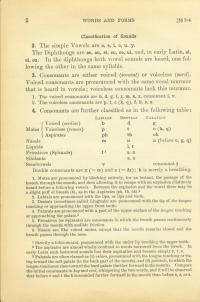2. The simple Vowels are a, e, i, o, u, y.
The Diphthongs are ae, au, ei, eu, oe, ui, and, in early Latin, ai, oi, ou. In the diphthongs both vowel sounds are heard, one following the other in the same syllable.
3. Consonants are either voiced (sonant) or voiceless (surd). Voiced consonants are pronounced with the same vocal murmur that is heard in vowels; voiceless consonants lack this murmur.
- The voiced consonants are b, d, g, l, r, m, n, z, consonantal i, and v.
- The voiceless consonants are p, t, c (k, q), f, h, s, and x.
4. Consonants are further classified as in the following table:
|
LABIALS |
DENTALS |
PALATALS |
||
|
Voiced |
b |
d |
g |
|
|
MUTES |
Voiceless |
p |
t |
c (k, q) |
|
Aspirates |
ph |
th |
ch |
|
|
NASALS |
m |
n |
n (before c, g, q) |
|
|
LIQUIDS |
l, r |
|||
|
FRICATIVES |
(Spirants) |
f1 |
s, z |
|
|
SIBILANTS |
s, z |
|||
|
SEMIVOWELS |
v |
consonant i |
Double consonants are x (= cs) and z (= dz); h is merely a breathing.
- Mutes are pronounced by blocking entirely, for an instant, the passage of the breath through the mouth, and then allowing it to escape with an explosion (distinctly heard before a following vowel). Between the explosion and the vowel there may be a slight puff of breath (h), as in the Aspirates (ph, th, ch).2
- Labials are pronounced with the lips, or lips and teeth.
- Dentals (sometimes called Linguals) are pronounced with the tip of the tongue touching or approaching the upper front teeth.
- Palatals are pronounced with a part of the upper surface of the tongue touching or approaching the palate.3
- Fricatives (or Spirants) are consonants in which the breath passes continuously through the mouth with audible friction.
- Nasals are like voiced mutes, except that the mouth remains closed and the breath passes through the nose.
5. The vowels i and u serve as consonants when pronounced rapidly before a vowel so as to stand in the same syllable.4 Consonantal i has the sound of English consonant y; consonantal u (v) that of English consonant w.
Consonantal i and u (v) are sometimes called Semivowels.
Note 1— The Latin alphabet did not distinguish between the vowel and consonant sounds of i and u, but used each letter (I and V) with a double value. In modern books i and u are often used for the vowel sounds, j and v for the consonant sounds; but in printing in capitals J and U are avoided: IVLIVS (Iūlius). The characters J and U are only slight modifications of the characters I and V. The ordinary English sounds of j and v did not exist in classical Latin, but consonantal u perhaps approached English v in the pronunciation of some persons.
Note 2— In the combinations qu, gu, and sometimes su, u seems to be the consonant (w). Thus, aqua, anguis, cōnsuētus (compare English quart, anguish, suave). In these combinations, however, u is reckoned neither as a vowel nor as a consonant.5
Footnotes
1. Strictly, a labio-dental, pronounced with the under lip touching the upper teeth
2. The aspirates are almost wholly confined to words borrowed from the Greek. In early Latin such borrowed sounds lost their aspiration and became simply p, t, c.
3. Palatals are often classed as (1) velars, pronounced with the tongue touching or rising toward the soft palate (in the back part of the mouth), and (2) palatals, in which the tongue touches or rises toward the hard palate (farther forward in the mouth). Compare the initial consonants in key and cool, whispering the two words, and it will be observed that before e and i the k is sounded farther forward in the mouth than before a, o, or u.
4. Compare the English word Indian as pronounced in two syllables or in three.
5. In such words it is possible that the preceding consonant was labialized and that no distinct and separate consonantal u was heard.


